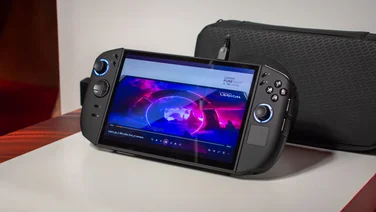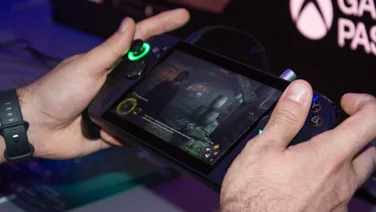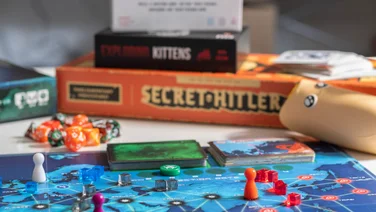To help us provide you with free impartial advice, we may earn a commission if you buy through links on our site. Learn more










- Superb Xbox-style controls
- Bright screen with rich and accurate colours
- Impressive sound
- Windows spoils the Xbox experience occasionally
- Steam Deck performance levels in the latest AAA games
Where the high-end ROG Xbox Ally X is a reasonably easy sell, it’s slightly tougher to define what the ROG Xbox Ally is or who it’s been designed for. On the one hand, it’s a slick PC gaming handheld, near-identical to the ROG Ally X and boasting the same great screen and Xbox software. Its white finish seems to pitch it as the handheld equivalent of the Xbox Series S to the Xbox Ally X’s Xbox Series X: an affordable version that’s less powerful, but still capable of running the same games.
In some respects, that’s not a bad way to look at it. The hardware is hard to fault, while the software delivers the most coherent and console-like experience yet of any Windows handheld. Yet there’s a chance that the ROG Xbox Ally is going to leave some Xbox fans disappointed. I’ll get into why a little later.
My review sample arrived later than expected, so I haven’t had time to run our full suite of benchmarks or spend as much time playing games on the ROG Xbox Ally as I’d like to before giving it a final verdict. As a result, this is a review in progress, and I’ll return with more results and final thoughts later this week.
What you need to know
This is the entry-level mode in Asus’s ROG Xbox Ally lineup: the result of a partnership with Microsoft that sees Asus supplying the hardware and Microsoft providing new software to make the user experience more handheld-friendly and Xbox-like. Over time, this software will roll out to other Windows handhelds, but right now, this is the only way to get it without signing up for one of Microsoft’s beta programmes.










The ROG Xbox Ally is virtually identical to its premium all-black stablemate, but with a few key differences. It’s 45g lighter, partly thanks to a lower-capacity 60Wh battery. It lacks the Xbox Ally X’s rumbling impulse triggers, and it only has 512GB rather than 1TB of storage. The really big distinction, though, is that it uses AMD’s new Ryzen Z2A processor rather than the high-end Ryzen 2 Extreme, and packs in 16GB of RAM to the Xbox Ally X’s 24GB.
Price and competition
Where the ROG Ally X (£799) is priced and specced to compete with mighty handhelds like the MSI Claw 8 AI+ and Lenovo Legion Go 2, the Ally (£499) has more affordable handhelds in its sights. These include the base model Lenovo Legion Go S, with its Ryzen Z2 Go processor and 16GB of RAM. This sells for around £499 to £550. It’s also up against the Steam Deck OLED, which can be found with 512GB of storage for £479.
The OG LCD Steam Deck is also an option, at just £349 for the 256GB model, while older Windows handhelds like the original Asus ROG Ally or the MSI Claw 7 A1M can be found for between £400 and £600, or even less if you can find a refurbished deal on eBay. The Ally X is the cheapest of the new Windows handhelds, but if you’re happy with Steam OS and a Steam games library, it’s far from the only game in town.
Design and connectivity
As with the ROG Xbox Ally X, Asus has focused on making the ROG Xbox Ally look and feel like a first-party Xbox handheld. It’s very solidly built, with some nice use of textures and no cheap or brittle-feeling plastics to be found. I actually prefer the white finish to the black ROG Xbox Ally X, as it’s easier to see the detail in the design.
The chunky grips might seem superfluous, but they make the Ally much easier to hold over long periods while giving it the feel of an Xbox controller, so that every stick, trigger and button sits almost exactly where you expect it to. This is one of the biggest strengths of the new Xbox handhelds. If you’ve spent the last twenty years or more playing on an Xbox, the adjustment time is virtually non-existent.










Only the function buttons take some getting used to. The Xbox button is now on the left of the screen, next to the View button and a button dedicated to Asus’s Armory Crate settings panel. On the right, you have the Menu button, plus a new button that takes you straight to your game library. For a while, I kept pressing the two new buttons instead of the Xbox buttons that you need to use in-game, but with time, I’ve adapted.
At 290mm wide and 121mm top to bottom, this is still one of the larger handhelds, and even with the weight reduction from 715g to 670g, it’s pretty heavy. Yet the ergonomics work so well that I could use the ROG Xbox Ally for long periods without any serious strain. It’s good sitting up with it perched on an armrest or your knee, and just as good lying down on the sofa with it resting lightly on your chest or stomach.










All the connectivity sits on the top edge, just above the cooling vents. As with the Xbox Ally X, you get a single USB4/Thunderbolt 4 Type-C port along with a USB 3.2 Gen 2 Type-C port. Both can charge the unit from a USB PD 3.0 charger like the one provided, or connect to a screen via DisplayPort 1.4. Towards the right-hand side, there’s a microSD card slot for extra storage along with a 3.5mm audio jack.
Internet connectivity is a must for downloading and streaming, so it’s good news that Asus has fitted a triple-band, 2×2 Wi-Fi 6E transceiver. Meanwhile, you have Bluetooth 5.2 for wireless keyboards, mice and headphones.
Controls
As I’ve said, familiarity is the name of the game here, so the layout of the thumbsticks, buttons and triggers ape the standard Xbox setup. The sticks have a more pronounced outer ring, which makes them more slip-resistant, while the triggers and bumpers are wider and have a glossier finish, with a textured area in the centre of the triggers for some extra grip.










The sticks are a good match for the Xbox sticks in terms of feel and sensitivity, while the ABXY buttons have a solid, clicky feel. Interestingly, the triggers and bumpers use Hall effect technology, boosting both their analogue sensitivity and their working life, which makes it curious that the twin sticks haven’t had the same treatment. Meanwhile, two additional small paddle triggers lurk on the back of the device, and you can customise what they do in the Armory Crate app.
I’ve played Xbox titles on other handhelds, but I can’t think of another that has so closely reproduced the feel of playing on an Xbox. Asus has done a fantastic job here.
Control modes
The ROG Xbox Ally has two distinct control modes. In Gamepad mode, the sticks, D-pad and buttons work just as you’d expect on a regular console, switching between areas and options, selecting with the A button and backing up with B. Given that you’ll spend most of your time within the Xbox app, you shouldn’t need to spend too much time in the alternative Desktop mode.










When you do, usually for installing games from non-Microsoft stores and services, you’ll find yourself hopping from icon to icon and button to button with the left stick and moving the pointer with the right. The right bumper acts as the left-click, with the right trigger acting as the right-click. It works, but doesn’t feel intuitive, and I found it much easier to navigate the desktop and the standard Windows settings using a Bluetooth mouse. The touchscreen is an alternative, but not precise enough to do the job without a few mistakes along the way.
Software
The big news here is that the Xbox app has been updated to provide a more console-like experience, with a new ‘full-screen experience’ that you can operate entirely through the gamepad controls. The ROG Xbox Ally launches into this full-screen experience by default, and through it you can access not just your installed games, Game Pass and Xbox games on the Microsoft store, but other major games stores and services, including Steam, Ubisoft Connect, EA Play, GoG and the Epic Games Store. You can even install the necessary launchers from within the Xbox app.
This is a big step forward, even if hopping out from the console-style Xbox app to a more PC-style launcher can feel strange. Luckily, once games are installed, you can launch them from within the Xbox app. Things can get weird when you’re working within Steam in Big Picture mode on an Xbox-branded handheld running Windows 11, but who cares when you can run all your games from a single launcher and you don’t need a mouse and keyboard.










Just to be clear, the ROG Xbox Ally won’t actually play Xbox games as such, only the PC versions released through Game Pass and the Microsoft Store. As a result, games you own on Xbox won’t appear in your library here unless they’re part of Microsoft’s Play Anywhere programme, where you’re licensed to run both versions.
Not everything works consistently. As with the Xbox Ally X, I’ve had times when an annoying pop-up or browser window appears outside the Xbox app, arresting all progress until I tracked it down. Sometimes the wait between launching a game and the splash screen loading is so long that you suspect the game isn’t loading. Having to mess around with Windows settings is still a pain, even if most of the game-related settings are accessible from within Asus’s Armory Crate app or the Xbox app. I also had a weird issue where I couldn’t get rid of the taskbar, even though I was running the Xbox full-screen experience. It went away after an overnight update and a restart, but it was annoying all the same.
It’s also a bit odd that you need to use Asus’s Armory Crate app and control panel for some features, including switching between performance profiles and customising the function of the two additional paddle keys on the rear of the device. Maybe it’s because these things are specific to Asus’s hardware, but it would still be better if we could handle everything from within the Xbox app.
Display
You might expect Asus to go cheap on the display to keep the budget down, but the screen here seems identical to the 7in 1080p screen on the ROG Xbox Ally X. In fact, of my two samples, it’s the slightly better screen. I measured brightness at 489.6cd/m2, just a few nits higher than the Xbox Ally X, and it beat the more expensive model on sRGB and DCI-P3 coverage too, albeit by a trifling 1%. With 96.1% sRGB coverage and 69.2% DCI-P3 coverage, colours are as saturated and vibrant as you could hope for on a non-OLED handheld, and colour accuracy is fantastic, with an average Delta E of 0.61.










In short, if games don’t look great on the ROG Xbox Ally, that’s nothing to do with the display. It’s punchy with a nice grasp of detail, and you’ll appreciate the extra resolution over the 800p screen of the Steam Deck on those games that the Ally can run at 1080p. Games should also sound great, thanks to speakers that deliver a surprisingly rich and rounded output with a wider than expected stereo spread. Avoid pushing the sound beyond the 60% point, and it’s perfectly good enough for some headphones-free gaming.
Performance
There’s just one thing I wish Asus had reconsidered on the ROG Xbox Ally, and that’s its choice of processor. It uses AMD’s new Ryzen Z2A processor with four Zen 2 CPU cores and eight RDNA2 graphics compute units, which is basically the same configuration that you’ll find in the Aerith chip on Valve’s Steam Deck. It’s not quite the same; it’s had a die shrink to 7nm and been given a higher maximum TDP of 20W. As a result, it’s supposed to be more energy efficient, while it can hit faster maximum clock speeds of up to 3.8GHz for the CPU and 1.8GHz for the GPU. All the same, I’d have loved to have seen the ROG Xbox Ally with something like the Ryzen Z2 Go, with its Zen3+ CPU cores and twelve RDNA2 CUs. Still, that processor was a Lenovo exclusive, so I guess that was always off the cards.
As it is, the ROG Xbox Ally is perfectly capable of running less demanding games, including indie titles and favourites from the PS4 and Xbox One era. Games like Dungeons of Hintenberg, Hollow Knight: Silksong and Planet of Lana run beautifully at 100 to 120fps at 1080p. The upgrade in resolution from the Steam Deck makes a big difference with Silksong’s detailed 2D art and makes for some stunning vistas.
As with the Steam Deck, you can also run many current-generation games if you drop the resolution or keep the detail settings low. I could play Forza Horizon 5 on Medium settings at 1080p with FSR 2.2 upscaling and still hit a very playable 40 to 50fps, even if 1080p High was a bit of a stretch, with 40fps in the 20W Turbo mode and 38fps in the 15W Performance mode.










Cyberpunk 2077 is also playable on Steam Deck settings, with 41fps at 720p with FSR3 upscaling. It’s just a bit embarrassing that the Steam Deck can do 46fps at the same settings.
More advanced AAA games may just about be playable, but only just. With Doom: The Dark Ages and its Abyssal Forest benchmark, you’re looking at 23fps at 720p Low settings or 28fps with upscaling. Don’t even think about 1080p. In practice, I found the game still roughly enjoyable at these settings, but – again – you can get the same results on the humble Steam Deck, even the basic LCD model. I had slightly better results with A Plague Tale: Requiem, where a combination of low settings, a 900p resolution and upscaling got me a playable 30fps, but the occasional drop down to 25fps or even 20fps showed that I was still pushing my luck.
This leaves me in a bit of a quandary. The ROG Xbox Ally is great for casual gaming with indie titles or older games, but won’t Xbox gamers be looking for something that can tackle the next Call of Duty or the latest hot Game Pass day one releases? If that’s what you want, the ROG Xbox Ally doesn’t really cut the mustard, and you really need to think about spending a little more on something with more CPU and GPU horsepower.










There is, of course, another way to play the latest Xbox games: through Xbox Game Pass Ultimate’s Cloud Streaming. The ROG Xbox Ally has the fast connectivity, controls and screen to do them justice this way, and I found I could play Gears of War: Reloaded and Avowed at a smooth 1080p/60 with both games looking great on a 7in screen, where Cloud Streaming’s softer image and artefacting aren’t so apparent.
You probably wouldn’t want to use the ROG Xbox Ally as a productivity PC, even with a mouse and keyboard connected and a monitor plugged in. Its Geekbench 6 scores, 1420 single-core and 4741 multi-core, are pretty low by the standard of most modern laptops, and that’s reflected in our 4K media benchmark results. The score of 132 is one of the lowest we’ve seen in recent times.
On the plus side, battery life seems to be pretty good, even with a smaller 60Wh battery. I found I could run Forza Horizon 5 for just over two hours in the 15W performance mode with medium settings at 1080p, which is roughly half an hour more than I’d expect from the Steam Deck with medium settings at 800p. With lighter indie titles, like Silksong or Dungeons of Hintenberg, an hour of gameplay only seemed to knock around 15 to 20% off the battery life. It can’t match up to the super-stamina of the ROG Xbox Ally X on video playback, but 11 hours and 51 minutes is still a stellar result.
Verdict
In most respects, this is a fantastic Xbox handheld. The design is familiar and comfortable, the screen is excellent, the sound impressive, and the software is a big improvement on what we’ve had with previous Windows efforts.
However, anyone buying it needs to know what they’re getting into. The Xbox Series S doesn’t always acquit itself brilliantly when running the most advanced Xbox games, but it can still run the same games as the Series X at playable frame rates with (mostly) decent visuals. I’m not sure you can say the same about the ROG Xbox Ally, or that an Xbox that plays last-gen games and indie favourites is what Xbox gamers are looking for.
There’s an argument that you can still play AAA titles through cloud streaming and run less demanding titles while you’re on the go, but I’m not sure that’s how Microsoft or Asus is marketing this console, and £499 is a lot to pay for a cloud streaming device.
With a different CPU, this could have been a real contender, but as it is, it’s a little overpriced and underspecced. It’s hard to justify the extra over the Steam Deck when the latter already does so much so well, and there are better options out there if you’re looking for a capable Xbox handheld.






